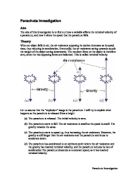A falling or sinking object always experiences two forces, weight and resistance. The faster something moves through a gas or liquid the greater the resistance acting on the moving object. Therefore an increase in speed causes an increase in resistance.
The weight of an object will cause it to fall through the air or sink in a liquid. As it falls or sinks it will accelerate and the resistance on the object will increase.
Therefore when an object falls or sinks, it initially accelerates due to gravity. A frictional force (air/water resistance) increases as the object falls or sinks faster and faster until it balances the weight (gravitational force) of the object. When the force of air/water resistance is equal to the weight of the object all the forces acting on the object are balanced and the object stops accelerating. At this stage the object falls at one, constant velocity called its terminal velocity.
Prediction:
I predict that, when the helicopter has more paperclips attached to it the time taken for it to reach the floor will decrease because the force pulling the helicopter down (gravity) is larger when it is heavier, whereas air resistance is the same. This means that the helicopter will still reach terminal velocity, however it will fall faster during terminal velocity. This is because the force pulling the helicopter down is equal to the resistance and air resistance.
Key Factors:
To make sure that the experiment is fair I will need to:
- Only change one factor in the experiment, in this case the number of paperclips on the helicopter
- Make sure the helicopter is dropped from the same height each time
- Make sure the helicopter is time correctly avoiding visual parallax by making sure the same person times the helicopter, and he focuses on a certain point and only starts the timer when the helicopter passes that point in his vision.
- The person timing the helicopter must stand the same distance away from the helicopter each time.
Diagram
This diagram shows how we will carry out the experiment.
Results
Conclusion
The results I have taken show that the more paperclips on the helicopter will increase the weight of the helicopter therefore decreasing the time taken for it to reach the floor, and increasing its terminal velocity. Due to the terminal velocity theory my predictions are correct, that the more paperclips on the helicopter the less time it will take for it to reach the floor due to drag, and air resistance. As the helicopters speed increases, and it falls faster, the resistance also increases. Therefore from my results I can see that weight increases the terminal velocity, thus affecting it. My three graphs compare how the number of paperclips (weight) affects the speed of the helicopter ( by making it go faster) how the number of paperclips affects the time taken (by decreasing the time taken), and compares the velocity and the time taken for the helicopter to reach the floor (that the faster the helicopter is going the less time it takes for it to reach the floor).
Evaluation
This experiment does prove how weight affects the terminal velocity of the helicopter, however the results may not be completely accurate for the following reasons:
- We are using human reactions to time the helicopter. Human reaction rates vary affecting the accuracy of the timings.
- There may be a drift of air affecting the time take for the helicopter to reach the floor.
- If allowed a visual parallax could affect the time taken for the helicopter to reach the floor.
By looking at my table and my graphs I can see one abnormal result. This is with 2 paperclips attached to the helicopter. The average time is unusually higher than the rest of the results near it, therefore affecting the velocity of the helicopter. I believe this is down to human error when the timer has been started or stopped incorrectly.
If I did the experiment again, I would try to improve the accuracy of the results by using other means for timing that helicopter, such as a laser to detect when the helicopter has passed it (similar to a light gate). This would also overcome the problem with a visual parallax. I would also close all windows and doors and make sure that no-one is moving too suddenly near where the experiment is being carried out, to avoid the drift.







